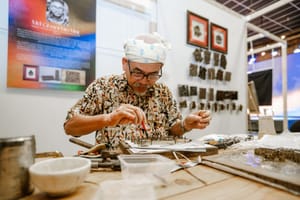I HAVE A strong affinity to textiles—probably because when I was a wee girl, I would often wan - der among rows and rows of rolls of fabric, while my mother, who was a seamstress, slowly picked out the materials she needed to make clothes for her customers. When I started working and began travelling around Southeast Asia, I would make it a point to stop by a textile store to pick up a few metres of fabric to bring home—my most treasured being the Cambodian Silk Ikat (known as chong kiet in Khmer) and the Royal Pahang Silk.

Previous Post
Wise to Have Travel Mishaps, Misfortunes and Misadventures Covered
6 min read
TRAVEL HAS SURELY picked up with the pandemic now in our collective rearview mirror for the most part. The numbers…
Next Post
Local History Matters Most Immediately
7 min read
IN THE GRAND theatre of social media—where cat videos reign supreme and discussions about anything often devolve into spirited…
You might also like
Dried Fish: A Luxury Born of Necessity
4 min read
Ikan bulu ayam, gelama tengkerong and ikan gelama tiga gigi are fish species usually dried because they are too bony to be worth cooking. Salt, which gives dried fish its distinctive flavour, is used in abundance for its antibacterial properties.
Revisiting Challenges in Conserving George Town’s Heritage Buildings
5 min read
Implementing conservation standards and monitoring mechanisms to conserve George Town’s heritage buildings remain complex, even after 17 years since its UNESCO inscription in 2008.
Tracing the Taste of Thailand in Penang’s Kitchens
7 min read
Penang’s proximity to Kedah and the long history of cross-border marriages and trade brought Thai culinary traditions southward, introducing the intense, spicy-sour palate that still defines much of northern Malaysian food today.





